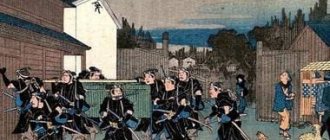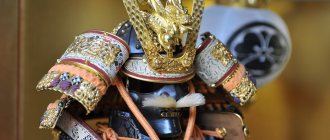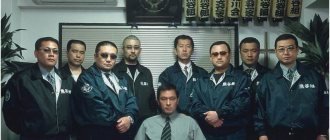According to the prevailing image in the West, samurai are valiant knights with iron principles who once lived in Japan. In fact, they were cruel mercenaries, sodomy was the rule among them, and profit was the main goal. And the Bushido code, which is so often referred to, is just a story invented by a Japanese who did not know the history of his country, and his ideas were subsequently successfully applied by militaristic ideologists.
Speaking about Japanese kamikazes of World War II, and in particular about the “father of kamikazes,” samurai Onishi Takijiro, it is often noted that they did not bring anything new to Japanese culture. After all, a samurai must die for his master bravely, willingly and with a smile on his face - as the Bushido code says! This is not entirely true: the kamikaze’s courage was perhaps unique in itself. And you have no idea how off-topic the Bushido code is here.
It is alleged that the code of Bushido (from Japanese - “the way of the warrior”) was formed in the 16th and 17th centuries. It contains the classic rules of samurai behavior and establishes his concepts of honor and duty. There is no single text of the code - it is as unwritten as the ancient set of rules “The Way of the Bow and the Horse” (“Kyuba no Michi”). But if the latter is mentioned in ancient Japanese texts, then we will not find any references to Bushido. After all, this code did not exist until the beginning of the 20th century, until it was invented by the Japanese writer Nitobe Inazo.
Samurai means “servant” in Japanese. They appeared in medieval Japan as a fighting force under their leaders. The relationship between the samurai and their masters was similar to the relationship between a squad and a prince. By the beginning of the 17th century, feudal wars in Japan ended with the unification of the country under the rule of the Tokugawa clan - the Edo era began, named after the clan's capital, Edo (present-day Tokyo). This era became the “golden age” of the samurai. Paradoxically, at the same time there was a decline in the class, which was completely eroded by the end of Edo, the mid-19th century.
Half a century later, Nitobe Inazo would make a career out of tales of noble and principled samurai, which later became an integral part of the Western cultural image of Japan. Here are some examples.
In the legendary 1957 film The Bridge on the River Kwai, Japanese camp commander Colonel Saito says to English officer Nicholson in response to his mention of the principles of the Geneva Convention: “What do you even know about the Soldier’s Code? About Bushido? Nothing! You are not worthy to command!
“Vostochka” has always attracted Europeans and had good commercial potential, which the authors of an increasing number of films and even video games began to use. In 1983, Enebel released one of the first 2D fighting games, called Bushido: Way of The Warrior. Let's not forget about Star Wars - the principles of the Jedi were largely built by Lucas on Bushido. Consider the scene from episode 4 where Darth Vader kills Obi-Wan: “You cannot win, Darth,” Obi-Wan says. “If you defeat me, I will become so strong that you cannot even imagine it” is a clear allusion to samurai honor, which remains untarnished only in case of death according to the principles of Bushido - death in loyalty to one’s principles and master. Let me remind you that Star Wars is largely based on Japanese culture and aesthetics as understood by George Lucas - for example, Darth Vader's helmet is modeled after a samurai helmet.
In the film “The Last Samurai” with Tom Cruise and Ken Watanabe, Watanabe’s hero, the brave samurai Katsumoto, shows miracles of nobility towards even his enemies and demonstrates high fighting spirit and fearlessness - “like a true samurai.” If the heroes really followed the true samurai traditions, then, as an English-speaking researcher of the issue aptly notes, the film should have had a love line, or even an erotic scene between the heroes of Cruise and Watanabe... What? Yes, our ideas about samurai are distorted to such an extent. But first things first.
Christian samurai
Nitobe Inazo
Nitobe was born in 1862 into an impoverished samurai family in Iwate Prefecture, a remote northern region of Japan. From the age of 9 he lived in Tokyo and studied a new subject for that time - English. Since 1877, Nitobe has been studying at an agricultural college in the even more northern prefecture of Hokkaido. In 1884 he moved to the USA. And it seems that he already knows the English language and culture better than Japanese.
At the same time, the Japanese realized how backward they were from European society and began major reforms, part of which was the deprivation of the samurai class of former privileges. Huge steps forward were the victorious wars - the Japanese-Chinese (1894-1895) and the Russian-Japanese (1904-1905). They proved to the Japanese that the abolition of samurai privileges and the restructuring of both the army and the entire society were really bearing fruit. But Europe still perceived the Japanese as a savage nation living under a feudal system. Nitobe decided to play on this, and in 1899 he published the book “Bushido. The Soul of Japan" - and written immediately in English.
Cover of the first edition of the book
Let's open the full text of the book. It's amazing how many authors reference Bushido and Nitobe's book, considering that Nitobe himself almost never cites Japanese literature or sources. The book begins with three epigraphs - from the English poet Robert Browning, the English historian Henry Hallam and the German writer Friedrich Schlegel. Nitobe often refers to Confucianism, Buddhism, and interprets Shintoism, but the wildest thing is that Nitobe builds samurai morality on Christian principles. Of course, all this was done for a specific purpose.
“I wanted to show that the Japanese are really not so different from Westerners,” Nitobe said in an interview. Well, he showed it in such a way that you’ll rock it. (The existing translation into Russian by Elena Fedorova contains errors that distort the meaning of the text, so the translation is mine). “The seeds of the Kingdom of God, so desired and accepted by the Japanese mind, flourished in Bushido. Now his days are numbered... The only ethical system strong enough to fight utilitarianism and materialism is Christianity, in comparison with which Bushido, it must be admitted, is only “smoking flax” (quote from the Book of the Prophet Isaiah, 42:3 - B.Z .), which, as the Messiah said, will not go out, but will only kindle into flames (he said this on another occasion - B.Z.) <...> The dominant, self-affirming “morality of the masters”, which Nietzsche wrote about, is itself similar in some respects on Bushido, is - if I am not much mistaken - a passing phase or temporary reaction to what Nietzsche calls the humble, self-denying morality of the Nazarene." Nietzsche? What the fuck did I just read?!
This is Nitobe’s argument. Moreover, he likens Japanese traditions to Christianity. In general, he himself professed it, and tried to interpret everything from this point of view. Thus, Nitobe associates seppuku - ritual suicide with the opening of the abdomen, also known as hara-kiri - with the Christian understanding of the abdomen as the center of vital energy. “They (the biblical Joseph, David, Isaiah and Jeremiah) supported the belief, common among the Japanese, that the stomach is the temple of the soul.” And he supports the samurai’s wearing of a sword with a quote from Romans 13:4: “But if you do evil, be afraid, for he does not bear the sword in vain.”
Bushido Code
This is your hara-kiri. Then who will clean up
O. Kagashira
The Bushido Code is a kind of code of samurai military honor for Japanese samurai.
The basis of the “Bushido Code” is the work of the Japanese samurai who lived in the seventeenth century - Yamamoto Tsunetomo, entitled “Hagakure” (“Hidden in the Leaves”) and the work of the samurai Yuzan Daidoji “Budoseshinshu” (in short, the “Code” as such (as accepted in European culture - a set of certain rules of law) in fact, there is no one - it is rather a collection of individual works of samurai who lived in the seventeenth and eighteenth centuries.
Download the Bushido Code from the Mail Ru Cloud
Book of Samurai. Bushido Yuzan Daidoji Budoseshinshu. Yamamoto Tsunetomo Hagakure. Yukio Mishima Hagakure Nyumon. Translation into Russian: Kotenko R.V., Mishchenko A.A.—SPb.: Eurasia, 2000. - 320 pp.
This is actually a very practical book with quite wise and at the same time practical advice, one might say, for all occasions in the life of a samurai, following which it is quite possible to become a truly integral and principled person. But again, all this advice - except, of course, advice on the “moral and volitional preparation” of samurai - has long been outdated. And most likely the “moral principles of the samurai” too - times have changed. For example, the idea of striving for death for the sake of one’s master in the modern world, even for the Japanese, looks somewhat ridiculous.
And the ideas, I repeat, are, in general, simply wonderful:
Quotes from the “Bushido Code” (actually from Yuzan Daidoji’s work “Budoseshinshu” - but no matter) :
The samurai must first of all constantly remember - remember day and night, from the morning when he picks up chopsticks to taste the New Year's meal until the last night of the old year when he pays his debts - that he must die. This is his main business.
For life is fleeting, like a drop of evening dew and morning frost, and even more so is the life of a warrior. And if he thinks that he can console himself with the thought of eternal service to his master or endless devotion to his relatives, something will happen that will make him neglect his duty to his master and forget about loyalty to his family.
Since the samurai is at the head of the three classes of society and is called upon to rule, he must be well educated and deeply understand the causes of things.
Now the empire is at peace, and although it cannot be said that those born into samurai families are indifferent to military affairs, they are not sent into battle at the age of fifteen or sixteen, like the warriors of former times. Therefore, at seven or eight years old, when the child has grown up, he must be introduced to the Four Books, the Pentateuch and the Seven Books, and also taught calligraphy so that he remembers how to write hieroglyphs. Then, when he is fifteen or sixteen, he should be taught archery, horse riding and all other martial arts, for this is the only way a samurai should train his sons in times of peace.
For today's warrior, unlike the warrior of the era of internal wars, illiteracy is unforgivable. But the children themselves should not be condemned for their lack of education. This is entirely the fault of their parents, who, through ignorance or neglect, do not exercise genuine love for their children.
One who is a samurai must conduct himself in strict accordance with the duty of filial piety. No matter how capable, intelligent, eloquent and kind he was born, all this is useless if he is disrespectful. For Bushido, the Way of the Warrior, requires that a person's behavior be correct in everything.
“Look for a loyal vassal among the respectful.”
There are two types of rules in Bushido, each with two types. The two types of rules are ordinary and unusual. Ordinary ones refer to officials and warriors, and unusual ones refer to the army and battle.
As for samurai officials, they must wash their hands and feet in the evening and morning and take a hot bath to always be clean.
He [the samurai] must always wear ceremonial clothing appropriate to the occasion, carry two swords and a fan at his waist.
Even a cup of rice or tea should be handled properly, without the slightest sloppiness and with vigilance.
But a samurai is an official in case of trouble, and when trouble arises in the state, he must throw aside the usual rules for a samurai and serve as a commander under his master, while other vassals become commanders and soldiers.
The most important thing is that a samurai should never neglect his fighting spirit, at any time and under any circumstances. For our country differs from other lands in that even the last of the people, peasants, traders and artisans, keep old rusty swords, and this shows the military spirit of the great Japanese Empire.
If you are a samurai and carry a sword on your belt, you should never forget about your fighting spirit. Then your mind is focused on death. A samurai who does not have a fighting spirit is like a peasant or merchant in the guise of a warrior, even if he has a sword on his belt.
Right and wrong are nothing more than good and evil, and although I do not deny that the difference between the words is slight, to do right and do good is considered tedious, and to do wrong and do evil is considered easy and pleasant, so it is natural that many tend towards the wrong or evil and dislike what is right and good.
However, in general, the code of right conduct states that we should first feel shame at the contempt of our family, servants and friends, then at the contempt of acquaintances and others, and therefore avoid wrong and do right. Then it becomes habitual and over time we will acquire a tendency to prefer what is right and hate what is wrong.
Bushido has three primary qualities: loyalty, correct behavior and courage. We are talking about a loyal warrior, a just warrior and a brave warrior, and only the one who is endowed with all three virtues is the best warrior.
Pointing a spear towards the master, knowing that he is there, talking about him, lounging on mats, throwing a letter from parents, or tearing it, or using it to clean a pipe or night light - all this indicates a lack of respect.
Anyone who is a samurai, even a minor vassal, must definitely find a suitable teacher and study the traditional martial arts in order to know everything there is to know about them.
I think that even now a minor vassal can become an army commander. In addition, the study of martial arts will make the naturally intelligent even smarter, and the naturally stupid will not be so hopeless.
If a samurai is dissatisfied with some of his wife’s actions, he must use reasonable arguments to convince her to agree with him. At the same time, in trifles it is better to be tolerant and condescending towards her.
A brave samurai never threatens someone weaker than him. He who loves and does what a brave man despises is rightly called a coward.
Samurai in service, high and low, must always be thrifty, but at the same time not skimp on the costs of maintaining the house.
The most important thing for a samurai in service is to communicate and make friends only among those of his comrades who are courageous, faithful to duty, intelligent and influential. But since there are few such people, you should choose among many friends one on whom you can completely rely if necessary.
Reliability is one of the qualities of the Way of the Warrior that is necessary for a samurai, but in no case is it advisable to provide assistance without good reason, to get involved in matters that do not matter, or to accept obligations in something that does not concern oneself, only for the sake of to do something or give advice.
Even if the matter concerns you to some extent, it is better to remain on the sidelines if no one asks you to intervene. After all, even minor issues, not to mention big ones, can lead to the fact that you cannot withdraw without risking your precious life, which should only be at the disposal of your master or parents. Therefore I say that a samurai should not assume obligations unnecessarily.
When a samurai of the past was asked for some favor, his first thought was whether it was worth doing or not; in the latter case, he immediately refused.
A samurai must constantly read ancient chronicles in order to strengthen his character.
A samurai must die, therefore his goal is to die in such a way that with his great valor he will amaze both friend and enemy, so that both the master and the commander will regret his death, so that his glorious name will remain in the memory of future generations.
A samurai on duty must travel with his luggage on a pack horse. He must tie both his swords together so that they do not slip out of their sheaths when they fall.
A samurai in the service of a master should never surreptitiously condemn the mistakes of his comrades that he has seen or heard about. For it is not given to a person to understand how wrong he can be in such things or not understand them.
Every samurai, great or small, high rank or low, must first think about how to face the inevitable death.
The samurai has military and construction duties.
They say that officials and white clothes are only good as long as they are new. Although this is a joke, I believe that this is true.
A samurai who has rendered his master a special service and believes that he has done something extraordinary, even if others also think so and praise him, must understand that the master himself may think differently.
A samurai in service owes a great debt to his master, which he cannot repay otherwise than by committing junshi and following him in death.
But if you look from the other side, the need to create such guidelines for the correct behavior of samurai warriors probably arose for a reason in Japanese society. After all, what should they be aimed at - the eradication of all sorts of shortcomings and vices, an incorrect way of life - examples of which, apparently, there were plenty of examples in Japan - “who cares, as they say.” And here is the need - to show how a noble person should act - to medieval people unfamiliar with this concept. But as far as I understand, the Japanese warriors accepted only external forms for themselves - and the ideas of nobility, apparently, did not really take root in the samurai environment - as they were cowardly egos
What, in my opinion, the results of the participation of “Japanese warriors” in the Second World War very, very clearly showed - how they were cowardly egoists capable of mocking the unarmed and weak (especially impressionable ones are better off not even looking) - that’s how they remained - for three hundred years “Code Bushido somehow didn’t help...
And this is actually quite a striking example - no matter how many people are told about all sorts of ideas of nobility and good behavior - both in Books and on TV and now on the Internet - and still - they take nothing - such is the Code of Bushido.
Samurai and male love
Describing samurai moral principles, Nitobe makes a lot of references to European chivalry and speaks of unblemished honor and loyalty to service. Meanwhile, samurai education was, among other things, based on sex between teacher and student.
In modern Japanese society, sodomy is a severe taboo. But for most of its history, Japanese society was extremely tolerant of any type of sexual intercourse. Suffice it to say that for centuries in Japan there was a tradition of fucking - when men went to unmarried women at night for semi-anonymous sex.
Shintoism, the main Japanese religion, encouraged sexual intercourse. In the 7th century, Buddhism came to Japan, in which abstinence from sexual intercourse was considered a virtue - but sex between men was considered just a loss of control, while sex with a woman was much more sinful. In the 12th-16th centuries, there were more than 90 thousand Buddhist monasteries in Japan, in which the monks spent 10-12 years, and they had to adapt their sex life to these conditions.
Among Buddhist monks, there was a tradition that came from China, called in Japan nanshoku (“male way”) - adult monks (“nenja”) took in young men (“chigo ” ), with whom they lived sexually until a certain age, after which both - the teacher and the matured pupil - found new “students”. The relationship between teacher and student was subject to rituals and rules and was perceived as a necessary part of the education of a monk.
The samurai readily adopted this tradition. The 17th century Japanese author Ihara Saikaku wrote: “Edo was a city of bachelors, like the monasteries of Mount Koya.” Transparent. The samurai taught their wakashu (the so-called youths who reached the age of 10–20 years) the martial art and the correct way of life, and the youths were their squires, servants, and seconds. The relationship did not necessarily end when the youth became an adult. He could find his own wakashu and still maintain contact with the teacher. Of course, sex with women was not forbidden, but relationships between men were perceived as more important and noble. Such relationships were also very beneficial directly for military affairs: students defended their nenja selflessly, cultivating fearlessness in battle.
A gentleman with his wakashu, 1680s
In the Edo era (1603 - 1868), the conventional Japanese modern era, when the samurai became basically not a military, but an administrative class, nanshoku relations turned into a kind of attribute of the elite. More attention than before was paid not to military affairs, but to the art of love. There were even textbooks! Here are the chapter titles from a Japanese textbook on male relationships from 1657:
“On exchanging views” “How to answer the first letter” “How to politely go home in the morning” “On feeling disgusted after one meeting” “On wakashu diseases” “On kisses and paper napkins”
…and so on. Other classes wanted to adopt this “elite” way of life and relationships. In 1700, a million people lived in Edo (future Tokyo), and 400 thousand each in Kyoto and Osaka. Merchants and artisans who came from the outback considered nanshoku a sign of a wealthy and cultured person. 1650s - 1750s - a time of boom in prostitution, free love and other samurai joys.
1750s
Does Nitobe have anything about this? In the entire text, neither nanshoku, nor wakashu, nor other terms are mentioned even once, and in the chapter “Education and the Place of Women,” questions of love are literally obscured by lengthy discussions about duty and the essence of marriage. Why, the word “sex” is used only in the meaning of “sex,” and when talking about the family, Nitobe quotes the Bible and European philosophers. In general, his samurai are chastity itself.
But even purely historically, by the time Nitobe was born, male love had ceased to be an attribute of the elite and, in general, to stand out in any way. Well, Christian missionaries who came to Japan during the Meiji era, of course, informed the Japanese about the concept of “sin of Sodom.” Homosexuality began to be prohibited at the government level, but still flourished in the Satsuma region - a kind of samurai enclave.
In 1877, a year after the ban on wearing swords for untitled samurai, it was in Satsuma that the last major samurai uprising took place, defeated by the regular army and showing the backwardness of the samurai. The samurai way of life gradually died out, although the nanshoku relationship was still associated with true masculine valor.
By the beginning of the 20th century, samurai traditions had become purely marginal. New times have come for Japan - and in them Nitobe’s ravings received a new, terrible application.
Edo period
The Edo period ushered in an unprecedented peaceful chapter in Japanese history. The samurai, while technically military, took over the administration and protection of their fiefs throughout Japan (on behalf of the Tokugawa regime). Bushido literature of the time contains many thoughts of samurai searching for their place in life, their attempts to apply martial principles and experience in times of peace, as well as reflections on the long history of wars and disasters on this land.
Yamaga Soko (山鹿素行, 1622–1685), philosopher, strategist, and staunch Confucian, became the leading theorist on samurai behavior. Focusing on a more general form of bushido based on pure Confucianism and emperor worship, which not only the samurai class but also the common populace had to follow. The samurai was equated with the Confucian “impeccable gentleman.” Children were taught that their main function was to serve as an example of virtue to the lower classes.
Obedience to authority was emphasized, but duty came first, even if this entailed a violation of statutory law . The extent to which debt crowded out everything else is perhaps best illustrated in the early 18th century the 47 ronin The samurai, who had lost their master (rōnin) after their master was treacherously killed, avenged the death of their master, and after this all were ordered to commit seppuku.
Storming the castle. 47 Ronin.
Yamaga thought of the samurai as "warrior-sages" and focused his writings on refining this "transcendental ideal", justifying their development from a purely military aristocracy into a category of political and intellectual leaders. However, he soon quarreled with the Tokugawa bakufu, burned his works and was expelled.
Heil shogun
“In various ways, Bushido seeped out from the class in which it originated and acted like a leavening agent among the people, setting the moral standard for the entire nation,” Nitobe wrote. It is ironic that, as we saw above, samurai debauchery was indeed popular among the people of the late Edo era. But of course, the author means something else - that the samurai principles of honor were adopted by ordinary people. This ideologeme was perfectly suited to support the patriotic spirit of the new Japanese army. Everyone wanted to feel like a noble samurai. And the goals of the new Japanese government were absolutely conquest-oriented.
Since the victory in the Russo-Japanese War, Japanese policy has become increasingly militarized. In 1910, Korea was annexed by Japan; After World War I, Japan also gained more territories and became one of the founding states of the League of Nations. And after Hirohito took the throne in 1926, the government finally set its sights on raising a nation of suicide warriors.
Kamikaze squad with swords - symbols of “samurai valor”
“Civilization and Enlightenment” and “Rich Country, Strong Army” became the official slogans. Ideologists began to actively seek out “suitable” texts from the past that would support the idea of dying for the state. As a result of these searches, the Hagakure book, created at the beginning of the 18th century and preaching the “Way of Death,” was discovered for two centuries as a forgotten book. Again, in the literature it is customary to call “Hagakure” a “statement of the principles of Bushido” - however, the word Bushido is not in the text of the book. A philosophical treatise on the meaninglessness of life, based on Confucian and Zen ideas, Hagakure began to be used for military propaganda in the 1930s. But not only her - in 1935, novelist Eiji Yoshikawa published the book “Musashi” about the adventures of the legendary samurai Miyamoto Musashi, which was soon turned into a super popular comic book. “Bushido” also gained extraordinary popularity in this context. Soul of Japan."
Book "Musashi"
Nitobe himself, it must be said, was horrified by what was happening - according to his convictions, he was a pacifist. During the short period that Nitobe sat in the Japanese Diet, he even prepared a speech denouncing Prime Minister Tanaka Giichi and his militaristic policies. But in vain - Japan’s aggressive aspirations were insatiable. In 1933, Nitobe died in Canada, where he was attending a political conference.
It is unclear what consequences Nitobe expected from his book, which so distorted the history of Japan - although it seems that the author himself did not even understand how wrong he was. It is not surprising that his book eventually found application in the militaristic ideology that the Japanese government zealously supported when it entered World War II on the side of the Reich. Of course, people who voluntarily go to death for an idea are beneficial to any commander. And as in the case of Nazi Germany, these ideas turned out to be false in their very essence.
Ethics
Bushido was a strict code that demanded loyalty, devotion and honor until death. In bushido, if a samurai failed to defend his honor, he could regain it by committing seppuku (ritual suicide).
Bushido is based on the following principles:
- Loyalty and devotion (忠義【ちゅうぎ】chūgi): to one's feudal master.
- Morality and integrity (義【ぎ】gi)
- Honor (名誉【めいよ】meiyo)
- Respect and Gratitude (礼【れい】rei)
- Honesty and Loyalty (誠(P); 実【まこと】Makoto)
- Courage and Courage (勇【ゆう】yū)
- Friendliness and Humanity (仁【じん (P); にん】yū)
- Filial Piety (孝【こう; きょう】kō, kyō)
- Respect for the Elderly (悌【てい】tei)
- Wisdom (知; 智【ち】chi)
Knights and Samurai: Comparison of Feudal Structures in Japan and Europe
The first seven principles form the basis of the Japanese warrior code, and the other three can be considered as related virtues. In general, they are akin to the concept of chivalry in medieval Europe. The idea of bushido was first mentioned in 8th-century literature and became widespread as a philosophical concept during the Kamakura and Muromachi periods (11th to 16th centuries), when the basic conduct of a warrior was called "the way of the horse and the bow" (弓馬の道 kyūba no michi). The warrior ideal was embodied in the poetry and literature of the period, such as the Haike Monogatari, which depicts the Genpei War (源平合戦 Genpei Kassen) between the Minamoto (源) and Taira (平氏) clans.











